Disclaimer: If a dog needs to be muzzled, it should be sedated. Just because we can do something does not mean we should; it is important to consider the long-term impact of the interaction on the pet. The owner should be encouraged to desensitize their dog to wearing a basket-type muzzle.
Applying a muzzle can be necessary for some patients’ procedures to keep the handlers safe. The ability to apply a muzzle quickly and securely without increasing the stress and anxiety of the patient is critical.
Most veterinary clinics use cloth sleeve type muzzles. They are not recommended or intended for prolonged procedures. The snug fit prevents the patient from panting, which can increase the patient’s fear and anxiety. Basket-type muzzles should always be the first choice. They allow the patient to pant (which helps reduce their anxiety), eat, drink, and vomit.
If your clinic has not converted to the use of basket muzzle or is not fluent in applying basket muzzles quickly in fearful dogs, consider using these tips to reduce your patient’s anxiety when applying a cloth muzzle. Please note, if a patient requires muzzling, the owner should be sent home with a basket-type muzzle and instructions for desensitization and counter-conditioning to facilitate future veterinary visits.
Use a Styrofoam or paper cup* with a treat so the dog must stick its nose into the cup.
Treat at bottom of cup
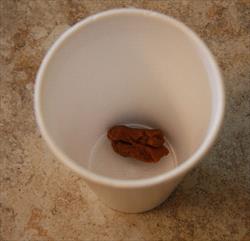
Photo courtesy of Colleen S. Koch
The cup should be short enough the dog is able to eat the treats at the bottom. If the dog has a short snout, you can cut the top edge of the cup so the dog's tongue can reach the treats.
Feed the dog treats in the cup; repeat several times.
Once the dog is readily putting their nose in the cup, it is time to add the muzzle.
Dog nose in cup
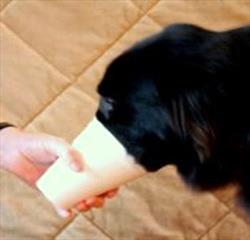
Photo courtesy Dr. Colleen S. Koch
The muzzle will be slipped inside the cup with the edges of the muzzle hanging over the edge of the cup (see pictures below). The muzzle is not applied to the dog yet.
Treat muzzle
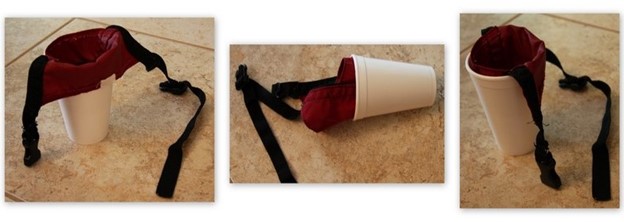
Photo courtesy Dr. Colleen S. Koch
The next step is to present the cup with treats in the bottom and the muzzle nested inside the cup.
Presenting Muzzle to Dog.jpg
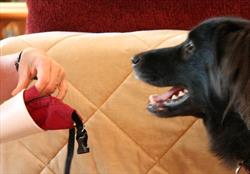
Photo courtesy of Colleen S. Koch
The current treat, and previous offers of treats in the cup, should encourage the dog to readily stick their nose in the cup with the muzzle nested inside. Repeat this step 2-3 times to encourage the dog to quickly put their nose in the cup with the muzzle.
Dog nose in muzzle inside cup
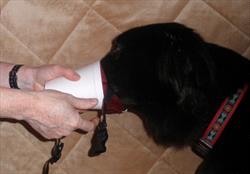
Photo courtesy of Colleen S. Koch
Next, slowly raise the strap on the muzzle as the dog continues to eat the treats.
Dog muzzle straps with cup
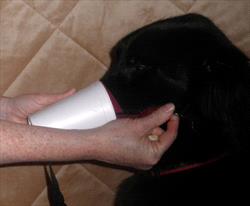
Photo courtesy of Colleen S. Koch
As long as the dog is distracted by the treats, continue to attach the strap. If the dog finishes the treats before the muzzle is applied, try to anticipate and remove the muzzle and cup before the dog is finished with the treats.
Repeat this process until the strap is applied. A longer-lasting treat may be required.
Dog muzzle with cup fastening straps
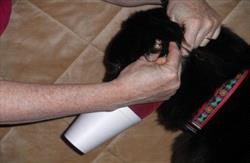
Photo courtesy of Colleen S. Koch
If at any time the dog struggles or backs away, stop and go back to the previous step.
Once the muzzle straps are attached, remove the cup and continue to feed treats while the dog is wearing the muzzle. The use of a tongue depressor, mixing spoon, or metal bowl may be used to keep hands away from the mouth if the patient is grabbing treats hard with their teeth.
Dog muzzle and treat
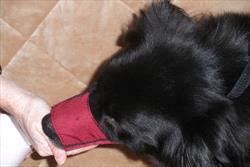
Photo courtesy of Colleen S. Koch
To remove the muzzle, offer the treat-filled cup for the dog to stick their nose in.
Removing dog muzzle using cup
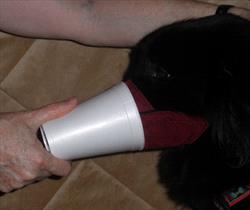
Photo courtesy of Colleen S. Koch
While the dog is distracted eating the treats, unfasten the muzzle.
*Helpful hints:
Have several cups ready with the dog's favorite treats, enabling you to move through the process quickly and easily.
Styrofoam and paper cups can have diluted chicken broth frozen in them to facilitate muzzle application prior to an injection and or surgery.
Deep stainless-steel bowls can be used instead of cups for more aggressive dogs and or those with larger snouts.